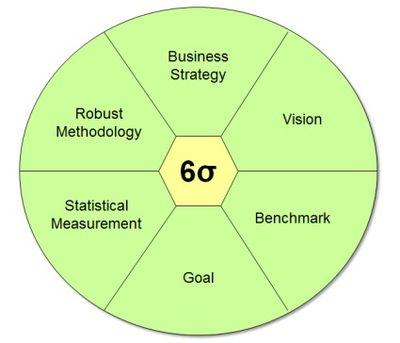Difference between revisions of "Six Sigma"
(Six Sigma at many organizations simply means a measure of quality that strives for near perfection. Six Sigma is a disciplined, data-driven approach and methodology for eliminating defects in any process) |
|||
| Line 1: | Line 1: | ||
| − | Six Sigma | + | '''Six Sigma''' is a disciplined, [[Data Driven Organization|data-driven approach and methodology]] for eliminating defects (driving toward six standard deviations between the mean and the nearest specification limit) in any process – from [[Manufacturing|manufacturing]] to [[Transaction Cost Theory|transactiona]]l and from [[Product|product]] to [[Service|service]]. Six Sigma at many [[Organization|organizations]] simply means a measure of quality that strives for near perfection.<ref>Definition - What Does Six Sigma Mean? [https://www.isixsigma.com/new-to-six-sigma/getting-started/what-six-sigma/ isixsigma.com]</ref> |
| + | |||
| + | '''Six Sigma is:'''<ref>What is Six Sigma? [https://www.sixsigma-institute.org/What_Is_Six_Sigma.php Six Sigma Institute]</ref> | ||
| + | *A [[Business Strategy]]: Using Six Sigma Methodology, a business can strategize its plan of action and drive revenue increase, cost reduction and process improvements in all parts of the organization. | ||
| + | *A [[Business Vision|Vision]]: Six Sigma Methodology helps the Senior Management create a vision to provide defect free, positive environment to the organization. | ||
| + | *A [[Benchmarking|Benchmark]]: Six Sigma Methodology helps in improving process metrics. Once the improved process metrics achieve stability; we can use Six Sigma methodology again to improve the newly stabilized process metrics. For example: The Cycle Time of Pizza Delivery is improved from 60 minutes to 45 minutes in a Pizza Delivery process by using Six Sigma methodology. Once the Pizza Delivery process stabilizes at 45 minutes, we could carry out another Six Sigma project to improve its cycle time from 45 minutes to 30 minutes. Thus, it is a benchmark. | ||
| + | *A [[Business Goals|Goal]]: Using Six Sigma methodology, organizations can keep a stringent goal for themselves and work towards achieving them during the course of the year. Right use of the methodology often leads these organizations to achieve these goals. | ||
| + | *A [[Statistics|Statistical Measure]]: Six Sigma is a data driven methodology. [[Statistical Analysis]] is used to identify [[Root Cause Analysis|root-causes of the problem]]. Additionally, Six Sigma methodology calculates the process performance using its own unit known as Sigma unit. | ||
| + | *A [[Methodology|Robust Methodology]]: Six Sigma is the only methodology available in the market today which is a documented methodology for problem solving. If used in the right manner, Six Sigma improvements are bullet-proof and they give high yielding returns. | ||
| + | |||
| + | |||
| + | [[File:Six_Sigma.jpg |400px|Six Sigma]]<br /> | ||
| + | source: Six Sigma Institute | ||
===See Also=== | ===See Also=== | ||
| − | [[Lean_Six_Sigma|Lean Six Sigma]] | + | [[Lean_Six_Sigma|Lean Six Sigma]]<br /> |
| + | [[TAKT Time]] | ||
===References=== | ===References=== | ||
<references /> | <references /> | ||
Revision as of 16:31, 27 February 2020
Six Sigma is a disciplined, data-driven approach and methodology for eliminating defects (driving toward six standard deviations between the mean and the nearest specification limit) in any process – from manufacturing to transactional and from product to service. Six Sigma at many organizations simply means a measure of quality that strives for near perfection.[1]
Six Sigma is:[2]
- A Business Strategy: Using Six Sigma Methodology, a business can strategize its plan of action and drive revenue increase, cost reduction and process improvements in all parts of the organization.
- A Vision: Six Sigma Methodology helps the Senior Management create a vision to provide defect free, positive environment to the organization.
- A Benchmark: Six Sigma Methodology helps in improving process metrics. Once the improved process metrics achieve stability; we can use Six Sigma methodology again to improve the newly stabilized process metrics. For example: The Cycle Time of Pizza Delivery is improved from 60 minutes to 45 minutes in a Pizza Delivery process by using Six Sigma methodology. Once the Pizza Delivery process stabilizes at 45 minutes, we could carry out another Six Sigma project to improve its cycle time from 45 minutes to 30 minutes. Thus, it is a benchmark.
- A Goal: Using Six Sigma methodology, organizations can keep a stringent goal for themselves and work towards achieving them during the course of the year. Right use of the methodology often leads these organizations to achieve these goals.
- A Statistical Measure: Six Sigma is a data driven methodology. Statistical Analysis is used to identify root-causes of the problem. Additionally, Six Sigma methodology calculates the process performance using its own unit known as Sigma unit.
- A Robust Methodology: Six Sigma is the only methodology available in the market today which is a documented methodology for problem solving. If used in the right manner, Six Sigma improvements are bullet-proof and they give high yielding returns.
See Also
References
- ↑ Definition - What Does Six Sigma Mean? isixsigma.com
- ↑ What is Six Sigma? Six Sigma Institute

